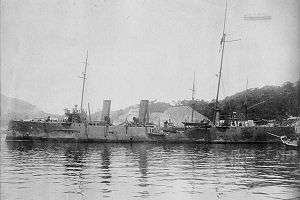Japanese cruiser Chihaya
Chihaya (千早) was an unprotected cruiser of the Imperial Japanese Navy.[1] The name Chihaya comes from Chihaya Castle, near Osaka, the site of one of the battles of the Genkō War of 1333.
 Chihaya in 1906 at Maizuru | |
| History | |
|---|---|
| Name: | Chihaya |
| Ordered: | 1896 Fiscal Year |
| Builder: | Yokosuka Naval Arsenal, Japan |
| Laid down: | 7 May 1898 |
| Launched: | 26 May 1900 |
| Completed: | 9 September 1901 |
| Stricken: | 1 September 1929 |
| Fate: | Scrapped 25 July 1939 |
| General characteristics | |
| Type: | Unprotected cruiser |
| Displacement: | 1,238 long tons (1,258 t) |
| Length: | 83.19 m (272.9 ft) |
| Beam: | 9.63 m (31.6 ft) |
| Draft: | 3.35 m (11.0 ft) |
| Propulsion: | 2-shaft reciprocating VTE, 6,000 ihp (4,500 kW), 6 boilers, 344 tons coal |
| Speed: | 21 knots (24 mph; 39 km/h) |
| Complement: | 125 |
| Armament: |
|
Background
Chihaya was based on previous designs for dispatch vessels made by the French military advisor Emile Bertin, and was built in Japan by the Yokosuka Naval Arsenal. Due to her small size she is sometimes classified as a corvette or gunboat, but was used by the Imperial Japanese Navy primarily as an aviso (dispatch boat) for scouting, reconnaissance and delivery of his priority messages.
Design
Similar in design to Yaeyama and Miyako, Chihaya had a steel hull, and retained a full barque rigging with two masts for auxiliary sail propulsion in addition to her steam engine, which was 2-shaft reciprocating vertical triple-expansion engine with 6 cylindrical Normand boilers driving two shafts and developing 6,000 ihp (4,500 kW). Chihaya was armed with two QF 4.7 inch Gun Mk I–IVs guns and four QF 3 pounder Hotchkiss guns. In addition, she carried two torpedoes, mounted on the deck.[2]
Service record
Chihaya was laid down on 7 May 1898 and launched on 26 May 1900[3] in a ceremony attended by Emperor Meiji. She was completed on 9 September 1901.[3]
On the afternoon of 18 June 1901 while still on trials before formal commissioning, Chiyaha collided off Tateyama, Chiba with the destroyer Akebono, which was on a torpedo training exercise. Both vessels suffered from minor damage.
During the Russo-Japanese War of 1904-1905, Chiyaha participated in the naval Battle of Port Arthur and subsequent blockade of that port. She was subsequently at the Battle of the Yellow Sea and the Battle of Tsushima. As this latter battle, Chiyaha commanded a squadron of destroyers which sank the Russian battleship Knyaz Suvorov and repair ship Kamchatka.[4]
On 26 August 1912, Chiyaha was re-classified as a first-class gunboat .[3]
During the First World War, Chiyaha was assigned to patrols of former German Micronesia, which has been occupied by Japan during the early stages of the war.
From 1918 to 1923, Chiyaha was assigned to provide support for the Japanese intervention in Siberia in support of the White Movement armies against the Bolshevik Red Army by making patrols of the eastern coast of Russia. From May to October 1928, Chiyaha was converted at the Yokosuka Naval Arsenal to be a training vessel, and was removed from the navy list on 1 September 1928.[3] She was subsequently transferred to the Imperial Japanese Naval Academy, where she served as a training hulk until 25 July 1939. Her hulk was still afloat at Etajima at the end of World War II, when she was scrapped.[2]
Notes
- Jentsura, Hansgeorg (1976). Warships of the Imperial Japanese Navy, 1869-1945. Naval Institute Press. ISBN 0-87021-893-X. page 95
- Chesneau, Conway's All the World's Fighting Ships, 1860–1905, p. 234.
- Nishida, Ships of the Imperial Japanese Navy
- Willmott, H.P., Mark R. (2009). The Last Century of Sea Power: From Port Arthur to Chanak, 1894–1922,. Indiana University Press. ISBN 0253003563.
References
- Chesneau, Roger (1979). Conway's All the World's Fighting Ships, 1860–1905. Conway Maritime Press. ISBN 0-85177-133-5.
- Evans, David C.; Peattie, Mark R. (1997). Kaigun: Strategy, Tactics, and Technology in the Imperial Japanese Navy, 1887-1941. Annapolis, MD: Naval Institute Press. ISBN 0870211927.
- Howarth, Stephen (1983). The Fighting Ships of the Rising Sun: The Drama of the Imperial Japanese Navy, 1895-1945. Atheneum. ISBN 0689114028.
- Jentsura, Hansgeorg (1976). Warships of the Imperial Japanese Navy, 1869-1945. Annapolis, MD: Naval Institute Press. ISBN 087021893X.
- Roberts, John (ed). (1983). 'Warships of the world from 1860 to 1905 - Volume 2: United States, Japan and Russia. Bernard & Graefe Verlag, Koblenz. ISBN 3763754032.
- Roksund, Arne (2007). "The Jeune École: The Strategy of the Weak". In Hobson, Rolf; Kristiansen, Tom (eds.). Navies in Northern Waters 1721-2000. Leiden: Brill. ISBN 978-0-415-40774-8.
- Schencking, J. Charles (2005). Making Waves: Politics, Propaganda, And The Emergence Of The Imperial Japanese Navy, 1868-1922. Stanford University Press. ISBN 0804749779.